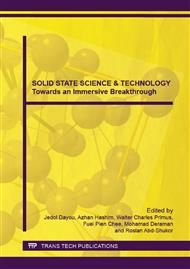[1]
R. C. Agrawal and R. K. Gupta, Review Superionic solids: composite electrolyte phase – an overview, Journal of Materials Science 34 (1999) 1131-1162.
Google Scholar
[2]
T. Inada, K. Takada, A. Kajiyama, M. Kouguchi, H. Sasaki, S. Kondo, M. Watanabe, M. Murayama, R. Kanno, Fabrications and properties of composite solid-state electrolytes, Solid State Ionics 158 (2003) 275-280.
DOI: 10.1016/s0167-2738(02)00823-8
Google Scholar
[3]
J. E. Trevey, Y. S. Jung and S. H. Lee, Preparation of Li2S-GeSe2-P2S5 electrolytes by a single step ball milling for all-solid-state lithium secondary batteries, Journal of Power Sources 195 (2010) 4984-4989.
DOI: 10.1016/j.jpowsour.2010.02.042
Google Scholar
[4]
B. Zhu, Z. H. Lai and B. –E. Mellander, Structure and ionic conductivity of lithium sulphate aluminum oxide ceramics, Solid State Ionic 70-71 (1994) 125-129.
DOI: 10.1016/0167-2738(94)90296-8
Google Scholar
[5]
P. K. Singh, K. –W. Kim, K. –I. Kim, N. –G. Park and H. –W. Rhee, Nanocrystalline porous TiO2 electrode with ionic liquid impregnated solid polymer electrolyte for dye sensitized solar cells. Journal of Nanoscience and Nanotechnology 8 (2008).
DOI: 10.1166/jnn.2008.1069
Google Scholar
[6]
C. C. Liang, Conduction Characteristics of the Lithium Iodide-Aluminum Oxide Solid Electrolytes. Journal of the Electrochemical Society 120 (1973) 1289.
DOI: 10.1149/1.2403248
Google Scholar
[7]
N. F. Uvarov, V. P. Isupov, V. Sharma and A. K. Shukla, Effect of morphology and particle size on the ionic conductivites of composite solid electrolytes. Solid State Ionics 51 (1992) 41-52.
DOI: 10.1016/0167-2738(92)90342-m
Google Scholar
[8]
V. G. Ponomareva, N. F. Uvarov, G. V. Lavrova and E. F. Hairetdinov, Composite protonic solid electrolytes in the CsHSO4-SiO2 system, Solid State Ionics 90 1996 161-166.
DOI: 10.1016/s0167-2738(96)00410-9
Google Scholar
[9]
M.M.E. Jacob, S. Rajendran, R. Gangadharan, M.S. Micheal and S.R.S. Prabaharan, Effect of dispersion of CeO2 in the ionic conductivity of Li2MnCl4, Solid State Ionics 86-88 (1996) 592-602.
DOI: 10.1016/0167-2738(96)00214-7
Google Scholar
[10]
R. C. Agrawal, R. K. Gupta, C. K. Sinha, R. Kumar and G. P. Pandey, Transport properties and battery discharge characteristics of the Ag+ ion conducting composite electrolyte system (1−x)[0. 75AgI: 0. 25AgCl]: xFe2O3, Ionics 10 (2004) 113-117.
DOI: 10.1007/bf02410317
Google Scholar
[11]
H. Yamada, I. Moriguchi and T. Kudo, Nano-structured Li-ionic conductive composite solid electrolyte synthesized by using mesoporous SiO2. Solid State Ionics 176 (2005) 945-953.
DOI: 10.1016/j.ssi.2004.11.013
Google Scholar
[12]
S. W. Kwon and S. B. Park, Effect of precursor on the preparation of lithium aluminate, Journal of Nuclear Materials 246 (1997) 131-138.
Google Scholar
[13]
M. Sulaiman, N. A. Dzulkurnain, A. A. Rahman and N. S. Mohamed, Sol-gel synthesis and characterization of LiNO3-Al2O3 composite solid electrolyte, Solid State Sciences 14 (2011) 127-132.
DOI: 10.1016/j.solidstatesciences.2011.11.008
Google Scholar
[14]
A. R. West, Solid State Chemistry and Its Applications, John Wiley and Sons, New York, (1984).
Google Scholar
[15]
W. Dieterich, O. Dürr, P. Pendzig, A. Bunde and A. Nitzan, Percolation concepts in solid state ionics, Physica A : Statistical Mechanics and its Applications 266 (1999) 229-237.
DOI: 10.1016/s0378-4371(98)00597-4
Google Scholar
[16]
N. F. Uvarov, Estimation of composites conductivity using a general mixing rule. Solid State Ionics 136-137 (2000) 1267-1272.
DOI: 10.1016/s0167-2738(00)00585-3
Google Scholar
[17]
M. Marzantowicz, J. R. Dygas, F. Krok, E. Z. Monikowska and Z. Florjancsyk, In-situ study of the influence of crystallization on the ionic conductivity of polymer electrolytes. Material Science Poland 24 (2006) 195-203.
DOI: 10.1016/j.electacta.2005.02.098
Google Scholar
[18]
Z. Gadjourova, Y. G. Andreev, D. P. Tunstall and P. G. Bruce, Ionic conductivity in crystalline polymer electrolytes, Nature 412 (2011) 520-523.
DOI: 10.1038/35087538
Google Scholar
[19]
A. Bunde, Application of percolation theory in composites and glasses, Solid State Ionics 75 (1995) 147-155.
DOI: 10.1016/0167-2738(94)00146-j
Google Scholar
[20]
R. H. Y. Subban, M. Z. A. Yahya, R. Puteh and A. K. Arof, Two percolations model for conductivity-salt concentration in PVC-LiPF6 system, Indonesian Journal of Physics 15 (2004) 51-53.
Google Scholar
[21]
N. F. Uvarov, E. F. Hairetdinov and I. V. Skobelev, Composite solid electrolytes MeNO3-Al2O3 (Me=Li, Na, K), Solid State Ionics 86-88 (1996) 577-580.
DOI: 10.1016/0167-2738(96)00208-1
Google Scholar
[22]
R. M. Neagu, E. Neagu, N. Bonanos and P. Pisses, Electrical conductivity studies in nylon 11, Journal of Applied Physics 88 (2000) 6669-6677.
DOI: 10.1063/1.1323752
Google Scholar
[23]
C. T. Moynihan, Analysis of electrical relaxation in glasses and melts with large concentrations of mobile ions, Journal of Non-Crystalline Solids 172-174 (1994) 1395-1407.
DOI: 10.1016/0022-3093(94)90668-8
Google Scholar
[24]
E. A. Rietman, M. L. Kaplan and R. J. Cava, Lithium ion poly(ethylene oxide)complexes. I. Effect of anion on conductivity, Solid State Ionics 17 (1985) 67-73.
DOI: 10.1016/0167-2738(85)90124-9
Google Scholar
[25]
S. Gopal, S. A. Agnihotry and V. D. Gupta, Ionic conductivity in poly(vinylbutyral) based polymeric electrolytes: Effect of Solvents and salts, Solar Energy Materials and Solar Cells 44 (1996) 6-12.
DOI: 10.1016/0927-0248(96)00023-2
Google Scholar
[26]
V. Aravindan, J. Gnanaraj, S. Madhavi and H. K. Liu, Lithium ion conducting electrolyte salts for lithium batteries, Chemistry – A European Journal 17 (2011) 14326-14346.
DOI: 10.1002/chem.201101486
Google Scholar


